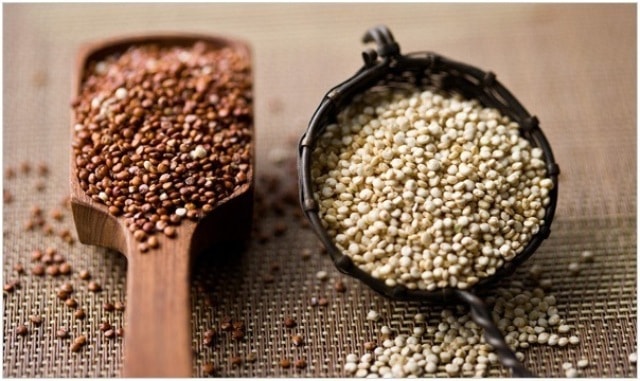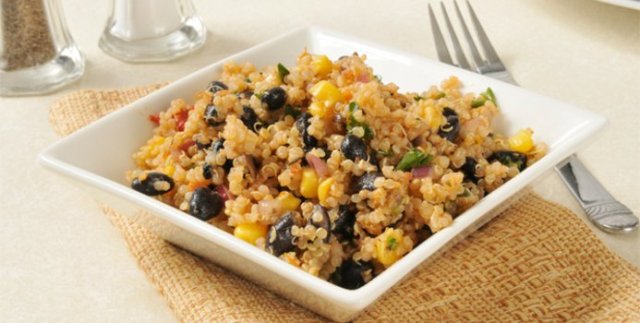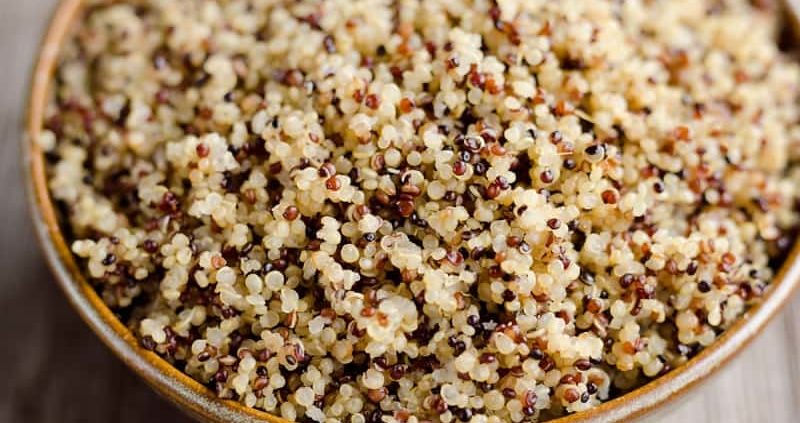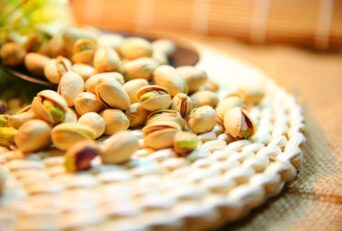Quinoa is a popular choice among the health-conscious around the world. Its benefits including high protein content, fiber, vitamins, and nutrients have been widely recognized.
While quinoa is considered a whole-grain food, technically it is not a grain at all. It is called a pseudocereal, since it is not a true cereal, unlike wheat, oats, and barley. However, it is cooked and eaten like cereals.
Quinoa is a relative of spinach, beets, and chard and the part we consume is actually the seed. It is gluten-free, contains high levels of protein with essential amino acids and is filling. This nutritional food is quite versatile and can be consumed through many different types of preparations.
Read on to discover the health benefits of quinoa and understand its nutritional value. You will also find out if eating quinoa can make you fat, besides exploring some ways to include this amazing food in your diet.
Table of Contents
Health Benefits Of Quinoa

Let us get started with the benefits of quinoa and why it is good for you.
1. High Fibre Content
Quinoa has high fiber content, containing nearly twice the amount of fiber found in most grains. This can keep you satisfied and feel full to help in weight loss.
Fibre helps to maintain smooth functioning of the digestive system and to maintain a healthy weight.
Varieties of quinoa have a range of 10 to 16 grams of fiber, per 100 grams. A cup of quinoa contains 17-27 grams of fiber. Boiled quinoa contains fewer amounts of fiber since it absorbs a lot of water.
Fibre binds to cholesterols and fat, which reduces the amount of cholesterol and fat absorbed by the body. It is also found to reduce the risk of heart disease and stroke.
2. Rich In Protein
Quinoa is a great source of protein, which is important for weight management.Quinoa contains nine essential amino acids, which are not produced by the body and need to be taken through diet.
A cup of quinoa contains 8 grams of quality protein. It is the ideal option for a plant-based protein source for those following a vegan diet. It contains all amino acids including lysine, which is lacking in many plant foods.According to the World Health Organisation, the amount of protein in quinoa is equivalent to its amount found in milk.
Protein is essential for building muscle and burns calories. It takes more energy to break down proteins as compared to fat or carbohydrates and makes you burn more calories.
=Protein makes you feel full and keeps you satisfied longer. This makes you eat less and cuts down on calories intake.
3. Low Glycemic Index
Quinoa has a low glycemic index. Glycemic index is an indicator of how quickly foods affect blood sugar levels.Consuming foods with a high glycemic index can lead to sugar level fluctuations, increase hunger and can lead to obesity. Such foods have also been associated with diabetes type2 and heart diseases.
An elevated sugar level in the blood can disrupt the normal functioning and increase your craving for more sugar.With a low glycemic index of 53, quinoa does not increase blood sugar. It can help to stabilize sugar levels and prevent diabetes.
4. Contains The Flavonoids
Quinoa contains flavonoids, which are plant antioxidants that are beneficial to the body.Quercetin and kaempferol are two flavonoids found in large quantities in quinoa. These help to fight inflammations and viruses, besides having anticancer and antidepressant properties.
5. Gluten-Free
Quinoa is a naturally gluten-free food, making it ideal for people with gluten intolerances.Using quinoa as a part of a gluten-free diet, instead of typical gluten-free foods can increase the nutrients and antioxidant value.
It also increases polyphenol content, which are compounds that protect the cells from damage caused by free radicals.
6. Rich In Antioxidants
Quinoa is high in antioxidants, which neutralize free radicals to fight aging and diseases. These also help to maintain healthy skin.
When compared with other cereals, quinoa is high in antioxidants like polyphenol, phenolic, and anthocyanin. These protect the heart, kidney, pancreas and other organs from oxidative stress.Antioxidant content is found to increase further if the seeds are sprouted.
7. Supports Metabolism
Quinoa improves metabolic health. Consuming quinoa has shown reductions in blood sugar and triglyceride levels. It also boosts muscle metabolism.
8. Vitamins And Nutrients
Modern dietary habits tend to deficient in essential nutrients such as magnesium, potassium, zinc, and iron. Quinoa can supplement daily diet to ensure adequate intake of these nutrients.
Nutrients found in quinoa include the following:
A. Potassium
Regular consumption of processed foods along with a reduction in the intake of fruits and vegetables leads to a drastic decrease in potassium intake.A cup of quinoa contains 9% of the recommended daily allowance of potassium.Potassium can lower blood pressure and the risk o osteoporosis. It also deals with hypercalciuria and kidney stones.
B. Zinc
Our body requires very small amounts of the trace element zinc.One cup of quinoa contains 13% of the recommended daily allowance of zinc.
Zinc deficiency affects the skin and liver. It is also an antioxidant that protects the body from oxidative damage due to free radicals.
Zinc provides protection from the sun’s radiation and maintains healthy skin. It also promotes healing of wounds. It also plays a role in immune and neural functioning.
C. Iron
Quinoa can provide a natural alternative o iron supplements. We get 15% of the recommended daily allowance of iron from a cup of quinoa.
It is important for the working of the immune and neural systems, besides boosting metabolism and energy production. Iron also helps in the regular brain and muscle function.
D. Magnesium
A cup of quinoa contains 30% of the recommended daily allowance of magnesium.Magnesium helps to prevent osteoporosis, diabetes, and cardiovascular disease. It also maintains normal blood pressure.
Quinoa is packed with essential amino acids and vitamin B, which helps in the nutrient synthesis and weight loss. While quinoa has a high content of minerals, it also contains phytic acid, which binds these minerals and hinders its absorption. Soaking or sprouting quinoa before cooking it reduces its content of phytic acid, to enable mineral absorption.
Quinoa is also high in oxalate, which decreases calcium absorption, and can prove problematic for people with recurring kidney stones.
9. Anti-Inflammatory Properties
Quinoa helps to reduce the risk of inflammation. Quinoa contains anti-inflammatory nutrients such as saponins. Polysaccharides, phenolic acids, and vitamin E present in quinoa have anti-inflammatory properties.
It prevents and treats inflammation by promoting healthy gut microbes. It also prevents obesity and improves metabolism.
10. Reduces Cholesterol
The high fiber content of quinoa can help to reduce cholesterol levels in the blood.By enhancing digestion, cholesterol is pulled from the blood to produce bile acid. This reduces the amount of bad cholesterol in the blood and produces results comparable to that by taking medications to reduce cholesterol.
11. Prevents Anemia
Being a rich source of iron, quinoa helps in the prevention of anemia, caused by iron deficiency.Anemia is a condition of deficiency of hemoglobin in the blood, which results in paleness and tiredness. This can result in disorders of the immune system and gastrointestinal tract and interferes with neural functioning.
Nutrition Values
Quinoa is an excellent source of proteins, including all the essential amino acids.
It is packed with nutrients such as magnesium, phosphorus, potassium, iron, calcium as well as vitamins. It contains phytonutrients and flavonoids, as well as anti-inflammatory polysaccharides.
One cup of cooked quinoa has nutrient content as follows:
- Protein:8 grams
- Fibre:5 grams
- Manganese:58% of the recommended daily allowance (RDA)
- Magnesium:30% of the RDA
- Phosphorus:28% of the RDA
- Folate:19% of the RDA
- Copper:18% of the RDA
- Iron:15% of the RDA
- Zinc:13% of the RDA
- Potassium:9% of the RDA
- Vitamins B1, B2, B6: about 10% of the RDA.
- Small amounts of vitamin B3, vitamin E, calcium, and omega-3 fatty acids.
A cup of cooked quinoa contains a total of 222 calories, with 39 grams of carbohydrates and 4 grams of fat.
Does Eating Quinoa Make You Fat?

Eating quinoa cannot make you fat. Like any other food, too much of it can make be fattening. The key to this issue lies in the amount of quinoa consumed.
Eating the right quantity and controlling the portions, can help in weight management. Being high in protein, quinoa will make you feel full and you would remain satisfied for long. This cuts down on your cravings, helps to burn calories and aids weight loss.
Calories that you take in through foods are used as energy to fuel various activities, throughout the day. Consuming lesser calories than what you burn results in weight loss since the body would then utilize the stored fat as an energy source.
However, by eating more calories than what is burnt, you would end up gaining weight, because the extra calories get stored as fat.
Normally quinoa is consumed along with other foods. You need to be careful while selecting the foods that go along with the quinoa since it is likely that these contain all the extra calories and fat that worries you.
When it comes to calories, a cup of cooked quinoa has 222 calories, while a cup of brown rice has 218 calories. While it does provide many benefits, do not mistake quinoa for a low-calorie alternative to other foods. Be sure to get your portions right.
Some Tips On Eating Quinoa
- Quinoa can be easily incorporated into your diet. It is very nutritious and can be combined with other foods in a variety of preparations. One cup of quinoa a day would be recommended.
- Processing quinoa usually involves removing the outer coat containing saponins. This compound keeps away insects and pest, while the crop is growing.
- Saponins give quinoa a bitter taste, which is why many people rinse the quinoa before cooking it. Wash the quinoa a few times with water, and rub the seeds to remove the bitter taste.
- To cook quinoa, take about two cups of water in a pot and set it to heat. Add one cup of quinoa and a pinch of salt. Allow it to boil for 15-20 minutes to get you cooked quinoa.
- Quinoa is light and fluffy after cooking and has a slightly nutty flavor. It takes a relatively short cooking time of just 15 minutes. The grain would normally appear translucent after cooking. You may also notice white string-like tails, which are the partially detached germ of the seed.
- It retains its texture well after cooling, and may be served hot, cooled to room temperatures or chilled.
- You can make quinoa a part of your healthy breakfast, by adding nuts and fruits to quinoa porridge.
- Include quinoa in salads, meatloaf, and burgers. You can also use sprouted quinoa in salads and sandwiches.
- It can be used in soups and stews.
- Quinoa flour can be used in baking.
- You can try replacing a rice or pasta recipe with quinoa.
- Instead of eating many portions of quinoa, add vegetables to supplement your meal, taking the right portions without adding up to calories or fat.
- You can try a combination of quinoa with various foods such as beans, coriander, kale, almonds, cauliflower, bell pepper, zucchini, mushrooms, eggplant or onion.
Precautions
While it is a popular food and provides many health benefits, there are a few things to keep in mind while consuming quinoa.
i. The coating of quinoa seeds contains Besides leaving a bitter taste in the mouth, it can irritate the stomach lining and cause damage to the small intestine.
ii. The high fiber content in quinoa can result in an upset stomach.
iii. If you are on medication or undergoing any treatment, you should consult your doctor, before consuming quinoa.
iv. It can also reduce triglyceride levels. Hence, you are advised to not consume quinoa if you are taking triglyceride-lowering drugs.






